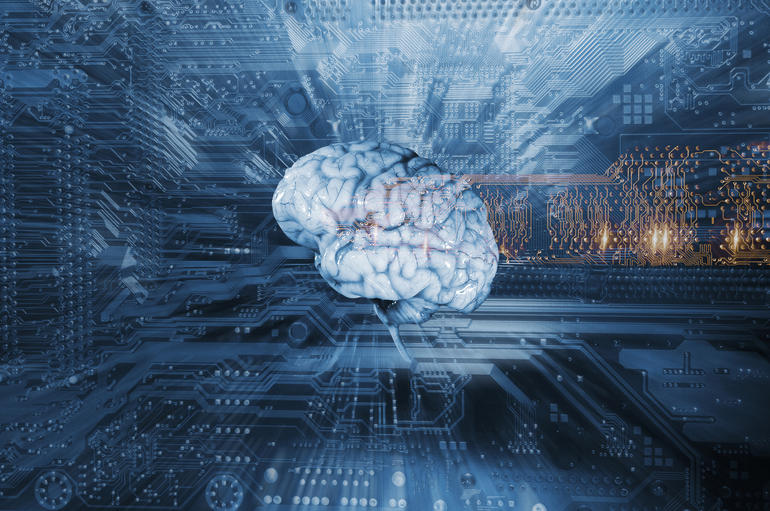The hype around deep learning
Deep learning is all the rage today, as companies across industries seek to use advanced computational techniques to find useful information hidden across huge swaths of data. While the field of artificial intelligence is decades old, breakthroughs in the field of artificial neural networks are driving the explosion of deep learning.
Decade old ideas now work
Attempts at creating artificial intelligence go back decades. In the wake of World War II, the English mathematician and codebreaker Alan Turning penned his definition for true artificial intelligence. Dubbed the Turing Test, a conversational machine would have to convince a human that he was talking to another human. It took 60 years, but a computer finally passed the Turing Test back in 2014, when a chat bot developed by the University of Reading dubbed “Eugene” convinced 33% of the judges convened by the Royal Society in London that he was real. It was the first time that the 30% threshold had been exceeded. Since then, the field of deep learning and AI has exploded as computers get closer to delivering human-level capabilities. Consumers have been inundated with an array of chat bots like Apple‘s Siri, Amazon‘s Alexa, and Microsoft‘s Cortana that use natural language processing and machine learning to answer questions.
Understanding and Neural Networks
Researchers have found that the combination of advanced neural networks, ready availability of huge masses of training data, and extremely powerful distributed GPU-based systems have given us the building blocks for creating intelligent, self-learning machines that can rival humans in understanding. As Google Fellow Jeff Dean explains, the rapid evolution in big data technologies over the past decade has positioned us well to now imbue machines with near human-level understanding. “We now have a pretty good handle on how to store and then perform computation on large data sets, so things like MapReduce and BigTable that we built at Google, and things like Spark and Hadoop really give you the tools that you need to manipulate and store data,” the legendary technologist said during last June’s Spark Summit in San Francisco. “But honestly, what we really want is not just a bunch of bits on disk that we can process,” Dean continues. “What we want [is] to be able to understand the data. We want to be able to take the data that our products or our systems can generate, and then built interesting levels of understanding.” […]
read more – copyright by www.datanami.com


The hype around deep learning
Deep learning is all the rage today, as companies across industries seek to use advanced computational techniques to find useful information hidden across huge swaths of data. While the field of artificial intelligence is decades old, breakthroughs in the field of artificial neural networks are driving the explosion of deep learning.
Decade old ideas now work
Attempts at creating artificial intelligence go back decades. In the wake of World War II, the English mathematician and codebreaker Alan Turning penned his definition for true artificial intelligence. Dubbed the Turing Test, a conversational machine would have to convince a human that he was talking to another human. It took 60 years, but a computer finally passed the Turing Test back in 2014, when a chat bot developed by the University of Reading dubbed “Eugene” convinced 33% of the judges convened by the Royal Society in London that he was real. It was the first time that the 30% threshold had been exceeded. Since then, the field of deep learning and AI has exploded as computers get closer to delivering human-level capabilities. Consumers have been inundated with an array of chat bots like Apple‘s Siri, Amazon‘s Alexa, and Microsoft‘s Cortana that use natural language processing and machine learning to answer questions.
Understanding and Neural Networks
Researchers have found that the combination of advanced neural networks, ready availability of huge masses of training data, and extremely powerful distributed GPU-based systems have given us the building blocks for creating intelligent, self-learning machines that can rival humans in understanding. As Google Fellow Jeff Dean explains, the rapid evolution in big data technologies over the past decade has positioned us well to now imbue machines with near human-level understanding. “We now have a pretty good handle on how to store and then perform computation on large data sets, so things like MapReduce and BigTable that we built at Google, and things like Spark and Hadoop really give you the tools that you need to manipulate and store data,” the legendary technologist said during last June’s Spark Summit in San Francisco. “But honestly, what we really want is not just a bunch of bits on disk that we can process,” Dean continues. “What we want [is] to be able to understand the data. We want to be able to take the data that our products or our systems can generate, and then built interesting levels of understanding.” […]
read more – copyright by www.datanami.com
Share this: